Facing harsh reviews from Republican lawmakers and some business leaders, Gov. J.B. Pritzker on Wednesday sought to deflect criticism over his five-phase plan to reopen the state by saying it was dictated by science and data, not by himself.
“I’m not the one holding the economy back from stage five; the COVID-19 virus is,” Pritzker said at this daily news briefing. “That’s the thing that’s been causing the very high infection rates, the hospitalizations and the deaths.”
Pritzker’s plan breaks the state down into four regions, each of which could reopen on its own timeline based on coronavirus infection rates, hospitalizations and other measures. None of the regions would fully reopen, however, until there’s a vaccine or effective, widely available treatment.
As he has throughout the state’s response to the coronavirus pandemic, Pritzker said he will continue to be guided by the advice of scientists and medical experts.
“We are listening to the scientists, the epidemiologists and the doctors about what’s best for the people who live in our state,” he said.
Earlier Wednesday, Illinois House Republicans held a videoconference to denounce Pritzker’s reopening plan, dubbed “Restore Illinois,” and called for the legislature to play a greater role in shaping plans for the state to reopen.
“This plan does not work,” House GOP leader Jim Durkin of Western Springs said.
“This plan presumes that the governor shall rule the state for the upcoming months — and possibly much longer — if the vaccination is not available,” Durkin said. “I took an oath of office to faithfully discharge my duties in the coequal branch of government called the legislature. I did not abdicate nor relinquish my elected responsibilities to the executive branch.”
Durkin said he appreciated Pritzker incorporating some suggestions from him and other members of his caucus in the modified stay-at-home order. But he said the General Assembly needs to have a greater role in determining how and when businesses are allowed to reopen. Senate Republican leader Bill Brady of Bloomington also has called for lawmakers to reconvene.

House GOP leader Jim Durkin, shown Jan. 29, 2020, is criticizing Gov. J.B. Pritzker’s five-phase plan to reopen the state amid the coronavirus pandemic.(E. Jason Wambsgans / Chicago Tribune)
Asked at his news conference about the response from House Republicans, Pritzker dismissed the criticisms as “kind of crazy,” saying he’s had discussion with the GOP leaders as well as their rank-and-file members and uses some of their ideas.
Republicans had been pushing for weeks to allow different regions of the state to reopen on different schedules based on local data.
“I don’t want to be in the position that I’ve been in, which is to put in emergency orders,” Pritzker said. “But I’ll say that we’re going to work through this together.”
“I’ll work with the legislature in any way that they’d like to work together,” he added.
Bolstering Pritzker’s argument, Illinois Department of Public Health Director Ngozi Ezike said that while the state’s actions so far have helped slow the spread of the virus, “we really aren’t that far from where we were a month ago or before we started the stay-at-home order.”
Officials on Wednesday announced 2,270 new known cases of COVID-19 and 136 more fatalities, bringing the total case count to 68,232 and the statewide death toll to 2,974 since the pandemic began.
After dipping to a two-week low on Monday, the number of daily deaths has topped 100 for the past two days, including a record high of 176 reported Tuesday.
Nearly 15,000 tests were conducted in the previous 24 hours, officials reported Wednesday, meaning the statewide rate for positive tests was about 15%. Under the reopening plan Pritzker released Tuesday, the positivity rate in any of the plan’s four regions must be at or under 20% and increase no more than 10 percentage points over a 14-day period, among other criteria, in order to move to the next phase.

Illinois Gov. J.B. Pritzker speaks during the daily press briefing regarding the coronavirus pandemic Sunday, May 3, 2020, at the James R. Thompson Center in Chicago.(Erin Hooley / Chicago Tribune)
Durkin called on House Speaker Michael Madigan to reconvene the House under safety guidelines prepared by the Illinois Department of Public Health.
“Speaker Madigan, you set the calendar,” Durkin said. “Mr. Speaker and the House Democrats, get back into the game. Get your head out of the sand, and let’s go back to work.”
In a statement, Madigan didn’t commit to anything, saying “we need to ensure the health and safety of members, staff and the general public is considered at all times when thinking about a return to Springfield.
“While the governor’s actions have reduced the curve and saved lives, it’s clear that Illinois is not out of the woods. Just yesterday, Illinois saw an all-time high in deaths, and it was recently announced that another 136 people died today.”
All the GOP House members on Wednesday’s call said they supported the governor’s stay-at-home order and appreciated the changes made in the new version that went into effect Friday — now labeled Phase 2 of the governor’s reopening plan.
But they said the four regions in the plan are arbitrary and that decisions about when to reopen should be evaluated on a more local level.
“We have some real input to offer, some guidance about how things might be done different,” said Rep. Tom Demmer, a Dixon Republican. “Just because we have disagreements over how a specific plan is structured doesn’t mean we’re ignoring the science that’s driving these decisions.”
Pritzker said that his plan breaks the state down into four regions based on hospital availability to make the system “more manageable.”
“No matter how we drew these lines, there were going to be people who might complain, but remember why they were drawn,” he said. “They were drawn because we want to make sure that there is health care availability.”
Durkin said the prolonged shutdown envisioned in the governor’s plan would be devastating to many of the state’s businesses, particularly in the restaurant industry, which wouldn’t be allowed to reopen for dine-in service until late June at the earliest.
“Without a smart, well-thought-out plan to reopen, there might not be anything left to reopen,” he said.
Some business groups also are bristling at the governor’s road map.
“The business community is happy that there is a plan, but they’re not happy that this is the plan,” Illinois Chamber of Commerce President and CEO Todd Maisch said. He predicted Pritzker would make changes in the coming days.
“While we respect his devotion to public health, he’s increasingly ignoring the economic crisis that is at hand,” Maisch said.
Particularly troubling to some business owners was that gatherings of up to 50 people won’t be allowed until the fourth phase of Pritzker’s plan, and it won’t be until the fifth phase that crowd restrictions are dropped. One movie theater chain operator called that “a very tough pill to swallow.”
In Chicago, Mayor Lori Lightfoot said she’s going to be proposing guidelines for the city that are separate from Pritzker’s but added that she understands people’s anxiety and businesses’ concern.
Breaking News Newsletter
As it happens
Get updates on the coronavirus pandemic and other news as it happens with our breaking email alerts
“I worry a lot, particularly about our microbusinesses and the workers that are affected and employed by those businesses,” Lightfoot said. “If there’s not a solution soon, they’re never coming back. They’ve already been devastated.”
Lightfoot said she wants to open the city, “but we have to do it safely and we have to do it at a time when we see there is actually a decline in cases.”
“But we can’t send people back to work, we can’t open up our city yet when we don’t see a decrease in the cases which we have not seen yet at all and when we don’t see a sustained decline in hospitalizations, ICU beds, all of those things are really important and the data has to drive what we do from a public policy standpoint,” she added.
Chicago Tribune’s Antonia Ayres-Brown and Rick Pearson contributed.






